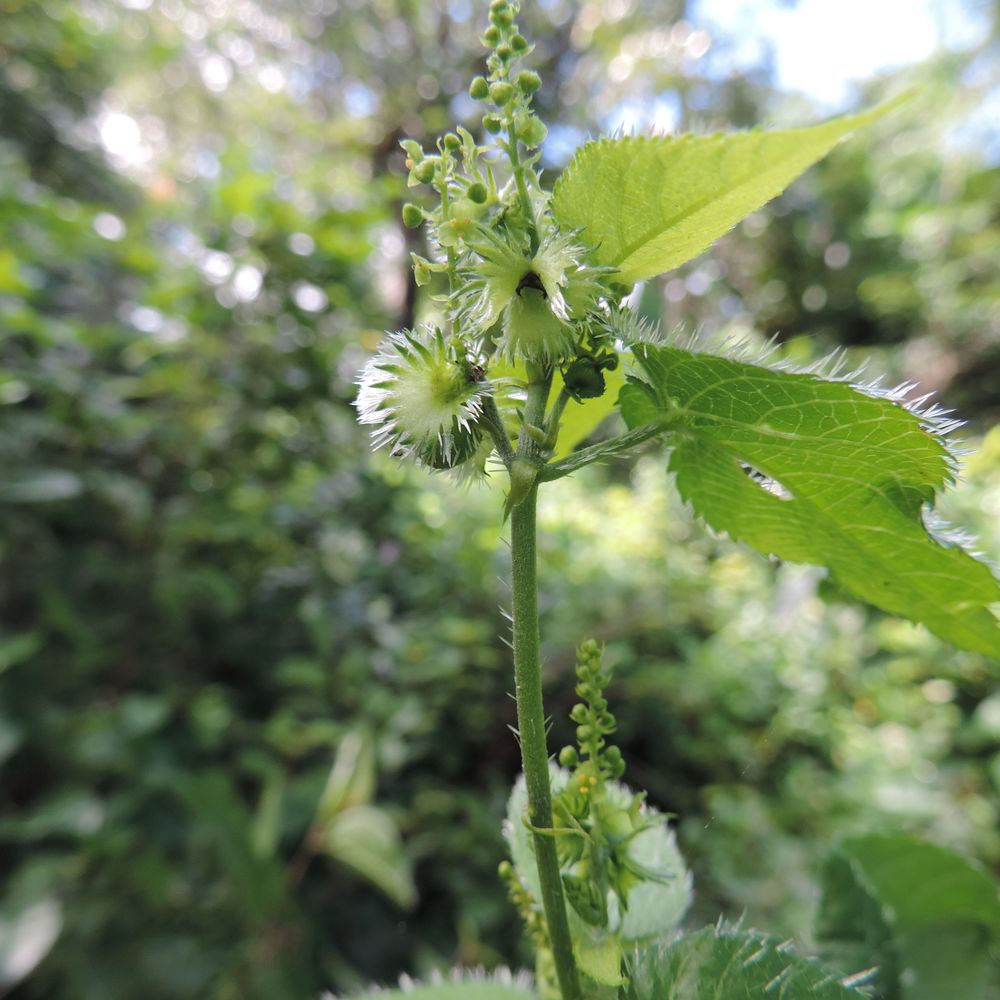Tragia benthamii

|
|
Tragia benthamii Common Names: Climbing nettle, African stinging nettle Scientific
Classification Kingdom: Plantae Clade: Tracheophytes Clade: Angiosperms Clade: Eudicots Clade: Rosids Order: Malpighiales Family: Euphorbiaceae Genus: Tragia Species: T. benthamii Synonyms: Tragia kassiliensis Beille, Tragia keniensis Rendle, Tragia mitis var. kirkii Müll.Arg. Morphological Description Tragia benthamii is a straggling or climbing plant, occasionally an erect
shrub, with woody stems 1–4.5 meters long. Its key characteristics include: · Stems: Slender, twining or erect, covered with stinging hairs;
woody at the base, green to reddish when young (Burkill, 1995). · Leaves: Alternate, ovate to lanceolate (3–10 cm × 1–5 cm), with
serrate margins; densely covered with stinging hairs, causing painful
irritation (Fern, 2024). · Flowers: Small, greenish-yellow, unisexual, in axillary racemes; male
flowers with 3–5 stamens, female flowers with a single pistil; bloom seasonally
(Prance & Jongkind, 2015). · Fruit: Capsules (5–8 mm diameter), trilobed, covered with stinging
hairs; split to release 3–6 spherical seeds (2–3 mm) (Duarte-Casar &
Romero-Benavides, 2021). Distribution and Habitat Tragia benthamii is widely distributed across tropical Africa, thriving in
diverse ecological niches: · Geographic Range: Native to West Africa (Nigeria, Ghana,
Benin, Ivory Coast), Central Africa (Cameroon, Gabon, Congo), East Africa
(Ethiopia, Uganda), and Southern Africa (Angola, Botswana, Zimbabwe,
Mozambique) (Kew Science, n.d.). · Habitat: Grows in floodplain thickets, termitaria in grasslands,
rocky outcrops, and mopane woodlands; prefers well-drained, sandy or loamy
soils (pH 5.5–7.0) with annual rainfall of 600–1,500 mm; occurs from sea level
to 1,000 m (Fern, 2024). · Ecological Role: Acts as a pioneer species in disturbed
areas; stinging hairs deter herbivores; supports pollinators like bees
(Burkill, 1995). Ethnopharmacology Tragia benthamii is extensively used in West and Central African traditional
medicine, with pharmacological studies validating several applications
(Duarte-Casar & Romero-Benavides, 2021): · Antimalarial: In Nigeria, leaf extracts treat malaria. Ethanolic leaf
extracts suppressed Plasmodium berghei parasitemia by 92–97% in mice, comparable to chloroquine,
due to alkaloids and flavonoids (Oladosu et al., 2013). · Antimicrobial: In Ghana, leaf extracts manage infections. Ethyl acetate
leaf extracts inhibited multi-drug-resistant Escherichia coli and Staphylococcus aureus (MIC: 50–100 μg/mL), linked to flavonoids
and tannins (Seukep et al., 2015). · Anti-inflammatory: In Ivory Coast, leaf poultices reduce
swelling. Methanolic leaf extracts contain cysteine-rich peptides with anti-inflammatory
activity, reducing paw edema in rats by 40% at 200 mg/kg (Attah et al., 2023). · Purgative: In Nigeria, root decoctions are used as purgatives for
children. The astringent properties of tannins support this use, though
specific validation is limited (Burkill, 1985). · Obstetric Uses: In Cameroon, root extracts aid childbirth
and act as abortifacients. Ethnopharmacological surveys confirm their use for
labor pains, but pharmacological data is scarce (Schmelzer & Gurib-Fakim,
2008). · Antiparasitic: In Nigeria, leaf extracts treat tapeworms. The presence of
saponins suggests anthelmintic potential, though direct studies are needed
(Duarte-Casar & Romero-Benavides, 2021). ⚠ Toxicity Profile: Tragia benthamii is covered with stinging hairs causing
painful irritation lasting ~10 minutes. In Côte d'Ivoire, it has been used in
harmful mixtures, indicating potential misuse. Acute toxicity studies showed no
mortality in rats at methanolic leaf extract doses up to 2,000 mg/kg, but
chronic use may elevate liver enzymes (ALT increased by 10% after 30 days).
High doses (>1,000 mg/kg) may cause gastrointestinal distress. Use is
contraindicated in pregnancy due to abortifacient properties and for children
due to insufficient safety data. Potential heavy metal contamination in
wild-harvested plants requires caution (Ripanda et al., 2023). Phytochemistry The bioactivity of Tragia benthamii is attributed to its diverse phytochemical
profile (Duarte-Casar & Romero-Benavides, 2021): · Flavonoids: Quercetin, kaempferol, contributing to antimicrobial and
anti-inflammatory effects (Seukep et al., 2015). · Peptides: Cysteine-rich peptides, with anti-inflammatory activity (Attah
et al., 2023). · Alkaloids: Present in roots, aiding antimalarial and purgative effects
(Oladosu et al., 2013). · Tannins: Found in leaves, supporting astringent and antimicrobial
properties (Burkill, 1985). · Saponins: Trace amounts, potentially contributing to antiparasitic
activity (Duarte-Casar & Romero-Benavides, 2021). Additional Uses · Cultural: In Yoruba culture, leaves are used in rituals for spiritual
cleansing, reflecting ethnobotanical significance (Burkill, 1985). · Pesticidal: Leaf extracts are used in Nigeria to repel insects in stored
grains, leveraging stinging compounds (Fern, 2024). · Ecological: Planted in agroforestry to stabilize soils; stinging hairs
deter grazing, aiding reforestation (Fern, 2024). References
External Links More Pictures |
|
| Compounds of Tragia benthamii |
|
| References |